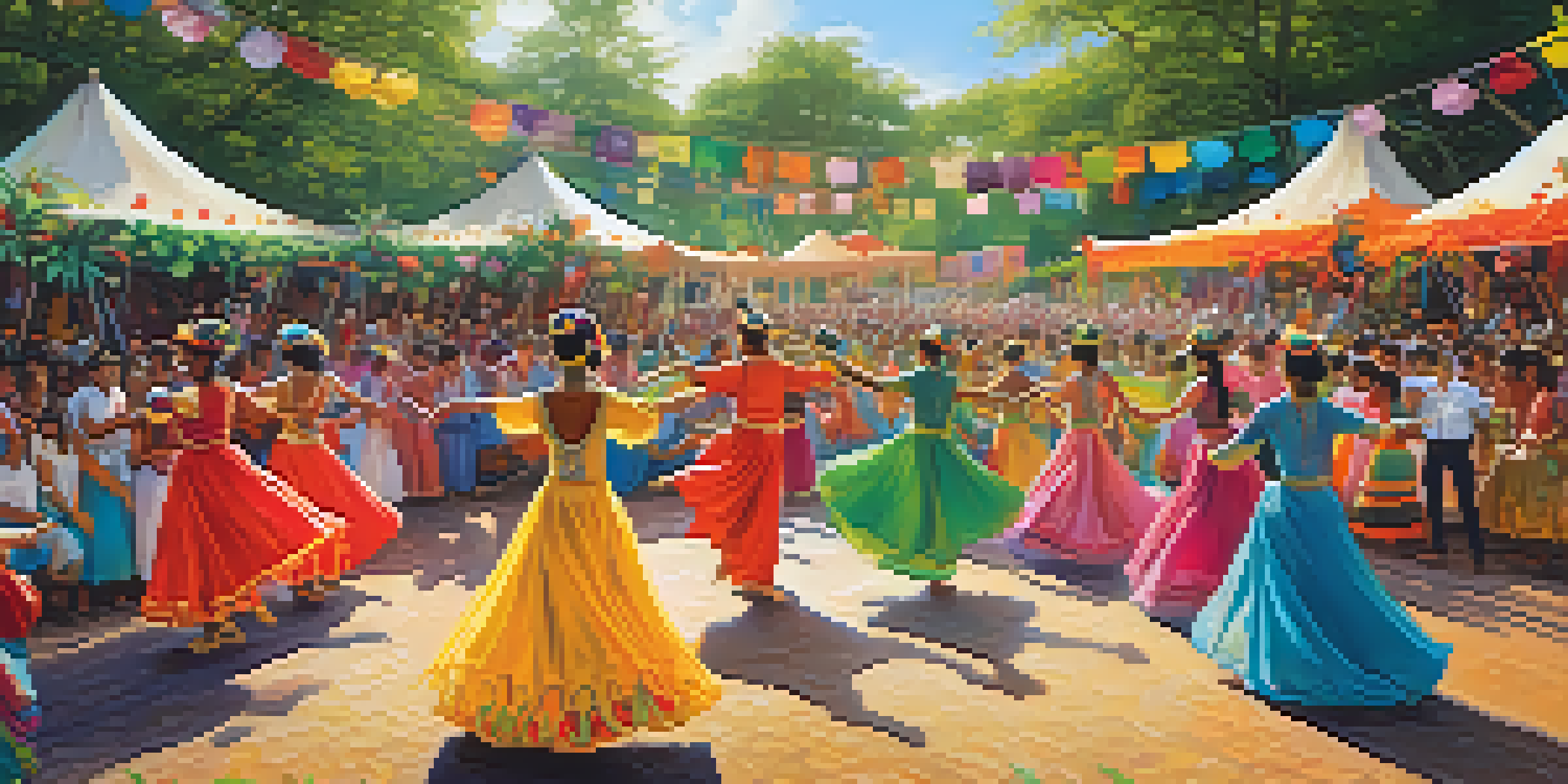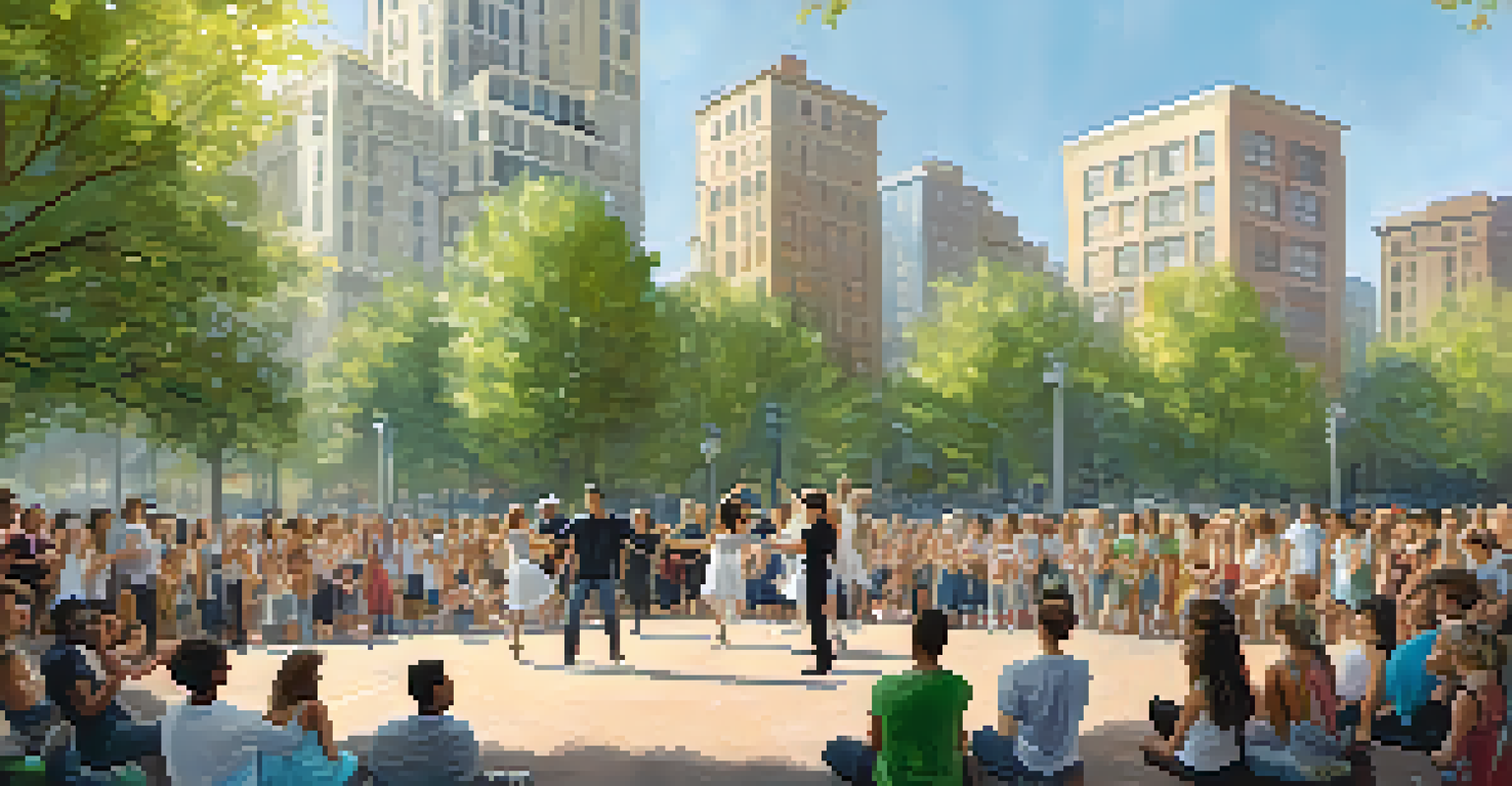The Impact of Dance on Public Perceptions of Sustainability

Dance as a Medium for Environmental Awareness
Dance has the unique ability to convey powerful messages in a visceral way. Through movement, dancers can express the urgency of environmental issues, making them relatable and emotionally resonant. For instance, a performance that highlights deforestation can visually represent the loss of trees and wildlife, stirring feelings that static images or statistics often fail to evoke.
Dance is the hidden language of the soul.
By integrating themes of sustainability into choreography, artists can inspire audiences to reflect on their own environmental habits. This connection between art and activism encourages viewers to engage in conversations about sustainability. Dance becomes not just a form of entertainment, but also a catalyst for change, prompting individuals to think about their role in protecting the planet.
Moreover, the communal experience of watching a dance performance can foster a sense of collective responsibility. When audiences witness the beauty of nature depicted through dance, they may leave feeling empowered to take action, whether that means reducing waste or supporting eco-friendly initiatives. This shared emotional journey amplifies the impact of the message.
Cultural Representation in Dance and Sustainability
Various cultures use dance as a storytelling tool, often reflecting their relationship with the environment. Traditional dances may celebrate nature, emphasizing the importance of harmonious living within it. By showcasing these cultural narratives, contemporary performances can highlight sustainable practices rooted in history, bridging the gap between past wisdom and modern challenges.

For example, Indigenous dance forms often incorporate elements that respect and honor the land. When featured in mainstream performances, they raise awareness about the need for sustainable practices and environmental justice. This cultural representation not only educates audiences but also fosters appreciation for diverse perspectives on sustainability.
Dance as an Eco-Activism Tool
Through powerful performances, dance conveys urgent environmental messages, inspiring audiences to engage in sustainability.
As dance continues to evolve, incorporating these cultural elements can lead to a deeper understanding of ecological issues. Audiences are invited to engage with sustainability from different viewpoints, enriching their perspectives. This inclusivity is crucial for building a more comprehensive approach to environmental stewardship.
Dance Festivals Promoting Sustainable Practices
Dance festivals are increasingly adopting sustainable practices, setting an example for the arts community. By prioritizing eco-friendly initiatives, such as reducing waste and using renewable resources, these events demonstrate the feasibility of sustainability in large gatherings. This not only lowers the environmental impact but also inspires attendees to implement similar practices in their own lives.
The best way to find yourself is to lose yourself in the service of others.
For instance, some festivals have introduced zero-waste policies, encouraging performers and audiences to minimize their ecological footprint. Workshops on sustainable living and art-making are often included, providing practical tools for individuals to take action. These immersive experiences allow participants to learn and connect with sustainability in a fun, engaging way.
As these festivals gain popularity, they serve as platforms for raising awareness about environmental issues. By showcasing dance performances that highlight sustainability, they reach diverse audiences, amplifying the conversation around ecological responsibility. This ripple effect can inspire changes in behavior long after the event concludes.
The Role of Dance in Climate Activism
Dance has emerged as a vibrant form of climate activism, using the power of movement to advocate for change. Choreographers and dancers often use their platforms to address pressing environmental concerns, creating pieces that call for action. This form of activism can resonate with audiences who may not respond to traditional advocacy methods.
For example, grassroots movements have used dance flash mobs to draw attention to climate strikes, blending art with activism. These performances create a sense of urgency while engaging participants and spectators alike. The visual spectacle of dance can attract media coverage, further amplifying the message and reaching wider audiences.
Cultural Narratives in Dance
Incorporating traditional dance forms highlights historical sustainable practices, bridging past wisdom with modern ecological challenges.
By framing sustainability through the lens of dance, activists can engage people emotionally, making the issues more digestible. This approach underscores the interconnectedness of art and activism, showcasing how creative expression can lead to meaningful discussions about climate change and inspire collective action.
Dance Education and Sustainable Practices
Integrating sustainability into dance education is crucial for nurturing environmentally conscious artists. By teaching students about the impact of their practices, educators can cultivate a new generation of dancers who prioritize ecological responsibility. This emphasis on sustainability encourages students to think critically about their art and its implications.
For instance, dance programs can incorporate lessons on sustainable costumes, set design, and production practices. By exploring eco-friendly materials and methods, students learn to minimize waste while still expressing their creativity. This hands-on approach empowers future dancers to make informed choices in their careers.
Moreover, fostering discussions about sustainability within dance classes can spark innovative ideas. Students can collaborate on projects that highlight environmental issues, further integrating their art with activism. This blend of creativity and awareness equips them to become advocates for sustainability in the dance community and beyond.
Audience Engagement Through Dance and Sustainability
Engaging audiences in discussions about sustainability through dance can create lasting impacts. Performances that include interactive elements invite viewers to participate, fostering a sense of ownership over the message. This engagement not only enriches the viewing experience but also deepens the audience's connection to the themes being presented.
For example, some performances incorporate post-show discussions where audiences can share their thoughts on sustainability issues raised during the dance. This dialogue encourages reflection and action, as attendees leave with new insights and a stronger commitment to environmental stewardship. The connection forged through shared experiences can lead to a collective movement towards sustainability.
Sustainable Practices in Festivals
Dance festivals are adopting eco-friendly initiatives, demonstrating that large events can promote sustainability and inspire attendees.
Additionally, using social media to extend the conversation can amplify the reach of these performances. Dancers and choreographers can encourage audiences to share their own sustainability journeys, creating a community of like-minded individuals. This sense of belonging fosters ongoing discussions and actions, reinforcing the impact of dance on public perceptions of sustainability.
The Future of Dance and Sustainability
As awareness of sustainability continues to grow, the role of dance in promoting ecological responsibility will likely expand. Artists and organizations are increasingly recognizing the importance of integrating environmental themes into their work. This shift not only reflects societal values but also positions dance as a vital part of the sustainability conversation.
Emerging technologies, such as virtual reality and interactive installations, may further enhance how dance communicates sustainability. These innovations can create immersive experiences, allowing audiences to engage with environmental issues in unprecedented ways. As the art form evolves, so too will the methods used to inspire change.

Ultimately, the relationship between dance and sustainability is poised to flourish. By embracing creativity and collaboration, the dance community can continue to lead the way in raising awareness and advocating for a sustainable future. This synergy has the potential to transform public perceptions, making sustainability a shared priority in the arts and beyond.